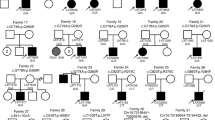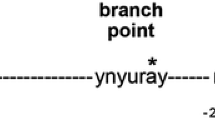Abstract
Purpose
The triple A syndrome (AAAS) is an inherited condition associated with mutations in the AAAS gene, which encodes a protein of 546 amino acids known as ALADIN (alacrima achalasia adrenal insufficiency neurologic disorder) whose function is not well understood. This protein belongs to the WD-repeat family of regulatory proteins and is located in the nuclear pore complexes. Only a few cohorts of AAAS patients have been reported and fully characterized. Thus, the objective of the present study was to report on a mini cohort of Italian AAAS patients and to get insights on their predisposing genetic defects.
Methods
Genetic analysis of AAAS gene in triple A syndrome patient and molecular and functional characterization of the novel identified allelic variants.
Results
Here we describe three newly diagnosed cases of AAAS, in whom genetic analysis allowed us to identify two novel allelic variants in the AAAS gene: the frameshift substitution c.765 dupT (p.Gly256Trp fsX67) in exon 8 and the splice site mutation in intron 11(c.997–2 A > G, IVS11-2A > G). Both variants result in a truncated non-functional protein, as we demonstrate by transcript analysis and expression studies.
Conclusions
Our findings establish a pathogenic role for both new variants. Moreover, our data highlight the essential role of the C-terminal domain of the protein for its correct targeting and function and underline the importance of sequencing splice sites surrounding the intron–exon junctions to ensure accurate molecular diagnosis and correct genetic counseling in AAAS patients.




Similar content being viewed by others
References
Cho AR, Yang KJ, Bae Y et al (2009) Tissue-specific expression and subcellular localization of ALADIN, the absence of which causes human triple A syndrome. Exp Mol Med 41:381–386. https://doi.org/10.3858/emm.2009.41.6.043
Allgrove J, Clayden GS, Grant DB, Macaulay JC (1978) Familial glucocorticoid deficiency with achalasia of the cardia and deficient tear production. Lancet (London, England) 1:1284–1286
Huebner A, Elias LL, Clark AJ (1999) ACTH resistance syndromes. J Pediatr Endocrinol Metab 12(Suppl 1):277–293
Tullio-Pelet A, Salomon R, Hadj-Rabia S et al (2000) Mutant WD-repeat protein in triple-A syndrome. Nat Genet 26:332–335. https://doi.org/10.1038/81642
Weber A, Wienker TF, Jung M et al (1996) Linkage of the gene for the triple A syndrome to chromosome 12q13 near the type II keratin gene cluster. Hum Mol Genet 5:2061–2066. https://doi.org/10.1093/hmg/5.12.2061
Papageorgiou L, Mimidis K, Katsani KR, Fakis G (2013) The genetic basis of triple A (Allgrove) syndrome in a Greek family. Gene 512:505–509. https://doi.org/10.1016/j.gene.2012.10.008
Huebner A, Kaindl AM, Knobeloch KP et al (2004) The triple A syndrome is due to mutations in ALADIN, a novel member of the nuclear pore complex. Endocr Res 30:891–899
Vallet A-E, Verschueren A, Petiot P et al (2012) Neurological features in adult Triple-A (Allgrove) syndrome. J Neurol 259:39–46. https://doi.org/10.1007/s00415-011-6115-9
Roucher-Boulez F, Brac de la Perriere A, Jacquez A et al (2018) Triple-A syndrome: a wide spectrum of adrenal dysfunction. Eur J Endocrinol 178:199–207. https://doi.org/10.1530/EJE-17-0642
Handschug K, Sperling S, Yoon SJ et al (2001) Triple A syndrome is caused by mutations in AAAS, a new WD-repeat protein gene. Hum Mol Genet 10:283–290. https://doi.org/10.1093/hmg/10.3.283
Cronshaw JM, Krutchinsky AN, Zhang W et al (2002) Proteomic analysis of the mammalian nuclear pore complex. J Cell Biol 158:915–927. https://doi.org/10.1083/jcb.200206106
Hirano M, Furiya Y, Asai H et al (2006) ALADINI482S causes selective failure of nuclear protein import and hypersensitivity to oxidative stress in triple A syndrome. Proc Natl Acad Sci USA 103:2298–2303. https://doi.org/10.1073/pnas.0505598103
Storr HL, Kind B, Parfitt DA et al (2009) Deficiency of ferritin heavy-chain nuclear import in triple a syndrome implies nuclear oxidative damage as the primary disease mechanism. Mol Endocrinol 23:2086–2094. https://doi.org/10.1210/me.2009-0056
Prasad R, Metherell LA, Clark AJ, Storr HL (2013) Deficiency of ALADIN impairs redox homeostasis in human adrenal cells and inhibits steroidogenesis. Endocrinology 154:3209–3218. https://doi.org/10.1210/en.2013-1241
Jühlen R, Idkowiak J, Taylor AE et al (2015) Role of ALADIN in human adrenocortical cells for oxidative stress response and steroidogenesis. PLoS ONE 10:e0124582. https://doi.org/10.1371/journal.pone.0124582
Carvalhal S, Ribeiro SA, Arocena M et al (2015) The nucleoporin ALADIN regulates Aurora A localization to ensure robust mitotic spindle formation. Mol Biol Cell 26:3424–3438. https://doi.org/10.1091/mbc.E15-02-0113
Sandrini F, Farmakidis C, Kirschner LS et al (2001) Spectrum of mutations of the AAAS gene in Allgrove syndrome: lack of mutations in six kindreds with isolated resistance to corticotropin. J Clin Endocrinol Metab 86:5433–5437. https://doi.org/10.1210/jcem.86.11.8037
Goizet C, Catargi B, Tison F et al (2002) Progressive bulbospinal amyotrophy in Triple A syndrome with AAAS gene mutation. Neurology 58:962–965. https://doi.org/10.1212/WNL.58.6.962
Wang W, Malcolm BA (1999) Two-stage PCR protocol allowing introduction of multiple mutations, deletions and insertions using QuikChange(TM) Site-Directed Mutagenesis. Biotechniques 26:680–682. https://doi.org/10.2144/99264st03
Krumbholz M, Koehler K, Huebner A (2006) Cellular localization of 17 natural mutant variants of ALADIN protein in triple A syndrome - shedding light on an unexpected splice mutation. Biochem Cell Biol 84:243–249. https://doi.org/10.1139/o05-198
Desmet F-O, Hamroun D, Lalande M et al (2009) Human Splicing Finder: an online bioinformatics tool to predict splicing signals. Nucleic Acids Res 37:e67. https://doi.org/10.1093/nar/gkp215
Smith TF, Gaitatzes C, Saxena K, Neer EJ (1999) The WD repeat: a common architecture for diverse functions. Trends Biochem Sci 24:181–185
Persic M, Prpić I, Huebner A, Severinski S (2001) Achalasia, alacrima, adrenal insufficiency, and autonomic dysfunction: double A, triple A, or quaternary A syndrome? J Pediatr Gastroenterol Nutr 33:503–504
Schmittmann-Ohters K, Huebner A, Richter-Unruh A, Hauffa BP (2001) Clinical and novel molecular findings in a 6.8-year-old Turkish boy with triple A syndrome. Horm Res 56:67–72. https://doi.org/10.1159/000048093
Houlden H, Smith S, De Carvalho M et al (2002) Clinical and genetic characterization of families with triple A (Allgrove) syndrome. Brain 125:2681–2690. https://doi.org/10.1093/brain/awf270
Gazarian M, Cowell CT, Bonney M, Grigor WG (1995) The “4A” syndrome: adrenocortical insufficiency associated with achalasia, alacrima, autonomic and other neurological abnormalities. Eur J Pediatr 154:18–23. https://doi.org/10.1007/bf01972967
Patt H, Koehler K, Lodha S et al (2017) Phenotype-genotype spectrum of AAA syndrome from Western India and systematic review of literature. Endocr Connect 6:901–913. https://doi.org/10.1530/EC-17-0255
Clark AJL, Weber A (1998) Adrenocorticotropin Insensitivity Syndromes. Endocr Rev 19:828–843. https://doi.org/10.1210/edrv.19.6.0351
Collares CVA, Antunes-Rodrigues J, Moreira AC et al (2008) Heterogeneity in the molecular basis of ACTH resistance syndrome. Eur J Endocrinol 159:61–68. https://doi.org/10.1530/EJE-08-0079
Maquat LE (2004) Nonsense-mediated mRNA decay: splicing, translation and mRNP dynamics. Nat Rev Mol Cell Biol 5:89–99. https://doi.org/10.1038/nrm1310
Cronshaw JM, Matunis MJ (2003) The nuclear pore complex protein ALADIN is mislocalized in triple A syndrome. Proc Natl Acad Sci USA 100:5823–5827. https://doi.org/10.1073/pnas.1031047100
Dumic M, Barišic N, Kusec V et al (2012) Long-term clinical follow-up and molecular genetic findings in eight patients with triple A syndrome. Eur J Pediatr 171:1453–1459. https://doi.org/10.1007/s00431-012-1745-1
Prpic I, Huebner A, Persic M et al (2003) Triple A syndrome: genotype-phenotype assessment. Clin Genet 63:415–417
Acknowledgements
This work was supported by funds from IRCCS Istituto Auxologico Italiano (Ricerca Corrente Funds: 05C822). Authors are in debt to Professor Sungjoo Kim Yoon (Catholic University of Korea) for providing them plasmid pEGFP-C1.
Author information
Authors and Affiliations
Corresponding author
Ethics declarations
Conflict of interest
The authors declare that they have no conflict of interest.
Ethical approval
The study, accomplishing the Declaration of Helsinki, was approved by Ethic Committee of the Istituto Auxologico Italiano.
Informed consent
All patients or their tutors gave a written informed consent.
Additional information
Publisher's Note
Springer Nature remains neutral with regard to jurisdictional claims in published maps and institutional affiliations.
Rights and permissions
About this article
Cite this article
Vezzoli, V., Duminuco, P., Pogliaghi, G. et al. Two novel truncating variants of the AAAS gene causative of the triple A syndrome. J Endocrinol Invest 43, 973–982 (2020). https://doi.org/10.1007/s40618-020-01180-1
Received:
Accepted:
Published:
Issue Date:
DOI: https://doi.org/10.1007/s40618-020-01180-1




